Heredity Short Question And Answers
In each question, two statements are given- one labelled Assertion and the other labelled Reason. Select the correct answer to these questions from the codes (A), (B), (C) and (D) as given below :
- Both assertion and reason are true and reason is a correct explanation of the assertion.
- Both assertion and reason are true but reason is not the correct explanation of the assertion.
- Assertion is true but reason is false.
- The assertion is false but the reason is true.
Question 1. Assertion (A). The sex of a child in human beings will be determined by the type of chromosome he or she inherits from the father.
Reason (R). A child who inherits an ‘X’ chromosome from his father would be a girl (XX) while a child who inherits a ‘Y’ chromosome from the father would be a boy (XY).
Answer: (1)
The sex of the children is determined by what they inherit from their father and not the mother. Justify.
Answer:
Women are homogametic. They produce one type of ova 22 + X. Men are heterogametic. They have two types of sperms, androsperms (22 + Y) and gynosperms (22 + X). During fertilization, it is the sperm type which determines the sex of the child—male (22 + X and 22 + Y or 44 + XY) or female (22 + X and 22 + X or 44 +XX).
Read And Learn More PSEB Class 10 Biology
Question 2. State the importance of chromosomal differences between sperms and eggs of humans.
Answer:
The chromosomal difference between sperm and eggs of humans is basic to the determination of the sex of the child. Eggs are of one type carrying the genetic complement of 22 + X. Sperms are of two types, androsperms with 22 + Y chromosomes and gynosperms with 22 + X chromosomes. The two types of sperm determine the sex of the child. Justify.
Question 3. Name the organism Mendel used for his experiments. Explain F1 and F2 progeny obtained by Mendel when he bred tall and short varieties of the organisms he experimented with.
Answer:
The experimental organism used by Mendel was the Garden Pea (Pisum sativum). Mendel crossed a pure tall
Pea plant with a pure dwarf Pea plant. All the plants of the Fj generation were tall. On self-breeding plants of the F1 generation, Mendel obtained an F2 progeny of both tall and dwarf in the ratio of 3: 1. The presence of dwarf plants in the F2 generation shows that the factor of dwarfness was present in F1 plants but it did not express its effect due to its recessive nature. The factor for tallness is dominant.
PSEB Class 10 Biology Chapter 9 Heredity
Question 4. The genotype of a plant bearing purple flowers is PP and one with white flowers is pp. When these are crossed
What colour of flowers would you find in F1 progeny?
Give the percentage of white flowers if F1 plants are self-pollinated.
In what ratio would you find PP and Pp in F2 progeny? Draw a flowchart in support of your answer.
Answer:
Purple (b) 25 % (c) 1: 2
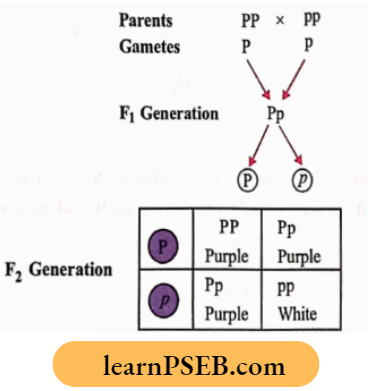
1 Pure: 2 hybrid purple: 1 pure white
Question 5. Why are some Pea plants tall and others short in nature? Explain with reference the role of genes in controlling characteristics.
Answer:
Genes are segments of DNA. They function in controlling body structure and its working through the synthesis of mRNAs. wRNAs take part in the formation of proteins. The proteins help in the synthesis of enzymes and other biochemicals.
The character of height is controlled by growth hormones. If the gene-controlling height is dominant, it helps in the synthesis of more hormones so that the plant becomes tall. If the gene is recessive, a less efficient protein and a smaller quantity of growth hormones would be produced. As a result, the plant remains dwarf.
Question 6. Explain how Mendel’s experiments show that traits are inherited independently.
Answer:
Mendel performed a dihybrid cross between round yellow-seeded and wrinkled green-seeded Pea plants. In F1 generation he obtained only round yellow seeded plants. Both traits are dominant and are expressed in hybrids.
He raised the F2 generation after the self-breeding of F1 plants. There were four types of F2 plants—round yellow (9/16), round green (3/16), wrinkled yellow (3/16) and wrinkled green (1/16). The combinations of round green and wrinkled yellow-seeded plants were new. They could arise only if the traits of the two characters could assort independently.
Question 7. One plant with dominant tall height bearing purple flowers is crossed with another plant having recessive dwarf and white flowers.
- What does the plant’s F1 generation look like?
- What type of cross is it?
- What is the phenotypic ratio in F2 generation and name the type of plants obtained according to phenotypic ratio?
Answer:
- Plants of generation are all tall and purple-flowered.
- Dihybrid cross as it involves two different characters.
- 9: 3 : 3: 1. Tall and purple flowered (9/16) tall and white flowered (3/16) dwarf and purple flowered (3/16) and dwarf and white flowered (1/16).
Question 8.
1. Name the sex chromosomes present in human males and human females.
2. With the help of a flowchart determine genetically in human beings the sex of the spring if the sperm carrying X chromosome fertilizes the egg.
Answer:
A. Sex chromosomes.
1. Human Male-XY
2. Human female-XX.
B. 22 + X (egg) and 22 + X (sperm) will produce a female baby (44 + XX).
PSEB Class 10 Biology Chapter 9 Question And Answers
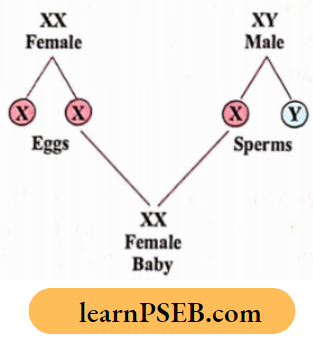
Question 9. Guinea pigs having black colour when crossed with guinea pigs having the same colour produced 100 offspring out of which 75 were black and 25 were white. Now find out :
- What is the possible genotype of guinea pigs?
- Which trait is dominant and which is recessive?
- What is this cross called and what is the ratio of F2 progeny obtained from this cross?
Answer:
- Genotype of Guinea Pigs. Bb, Bb.
- Black colour is dominant (B) while white colour (b) is recessive.
- Monohybrid cross. F2 progeny. 1 pure black (BB): 2 hybrid black (Bb): one white (bb).
Question 10.
- Name an animal which can change sex. What does it indicate?
- Name the trait which can express itself in the next generation.
Answer:
- Ophryotrocha(an annelid). It is male in the young state and female later. Sex is here determined non-genetically.
- Dominant trait.
Heredity PSEB Class 10 Notes
Question 11.
- Mendel selected the Pea plant for his experiments. List two reasons.
- State the meaning of recessive and dominant genes.
Answer:
- Mendel selected the Pea plant for his experiments because It can be cross-pollinated manually and self-pollinated automatically. It is annual with a short life span and a high yield of seeds.
- Recessive Gene: It is a gene or factor that cannot express its effect in the presence of its contrasting factor.
- Dominant Gene: It is a gene or factor which expresses its effect both in homozygous and heterozygous states.
Question 12. In a cross between plants with purple flowers and plants with white flowers, the offspring of the F1 generation had all purple flowers. When F1 generation individuals were self-bred, the F2 generation gave rise to 100 individuals, 75 of which had purple flowers. Make a cross and answer the following.
- What is the genotype of F2 individuals?
- What is the ratio of purple to white-flowered plants in F2 generation?
Answer:
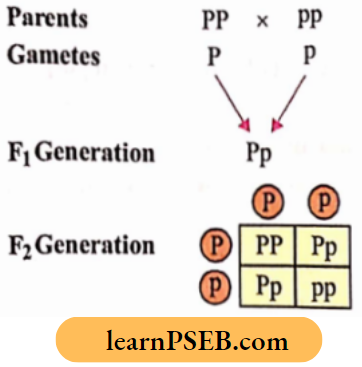
1PP (pure purple): 2 Pp (hybrid purple): pp (pure white)
- Genotypes of F2 Progeny. 1 PP: 2 Pp: 1 pp.
- Purple to white flowered ratio. 75: 25 or 3: 1.
Question 13. A husband has 46 chromosomes. His wife has 46 chromosomes. Then why does not their offspring have 46 pairs of chromosomes which is obtained by fusion of male and female gametes? Support your answer with an illustration.
Answer:
Gametogenesis is not a mitotic division. It is a meiotic division. Therefore, gametes do not possess the same chromosome number as the parents. Instead, they have half the number of chromosomes. As the mother has 46 chromosomes, the ovum will have 23 chromosomes.
Similarly, as the father has 46 chromosomes his sperm will have 23 chromosomes. The fusion of a sperm (23 chromosomes) and an ovum (23 chromosomes) restores the 46 chromosome number in the offspring. There is no chance of having 46 pairs of chromosomes.
PSEB Class 10 Biology Important Questions On Heredity
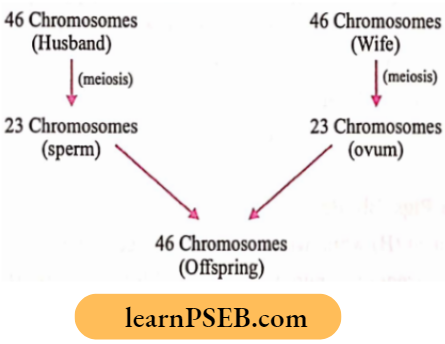
Question 14. “It is a matter of chance whether a couple will give birth to a boy or a girl”. Justify the statement and support your answer with a neat illustration.
Answer:
The wife produces only one type of ova, that is, 22 + X. The Husband has two kinds of sperm, 22 + X (gymnosperms) and 22 + Y (angiosperms) formed in equal numbers. It is a pure chance which type of sperm comes in contact with the ovum. If it is endosperm, a male child is born. If it is a gymnosperm, a female child is born.
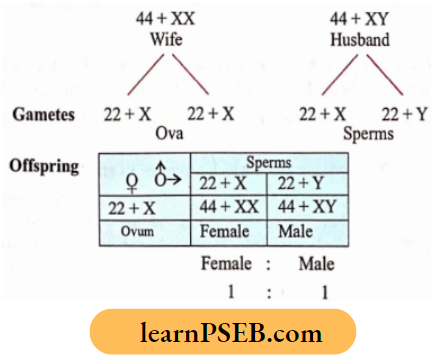
Question 15. A round-seeded plant (RR) Is crossed with a wrinkled-seeded plant (RR). Find out the phenotype and genotype of the F1 and F2 generations.
Answer:
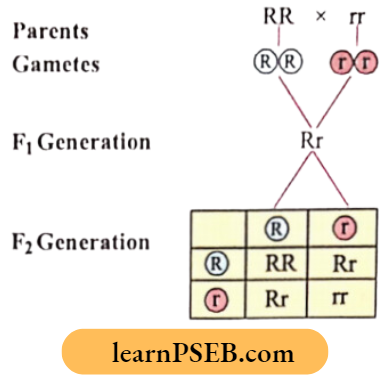
Phenotype of F1 generation = Round Seeded ; Genotype of F, generation = Rr
The phenotype of F2 generation = 3 round: 1 wrinkled
Genotype of F2 generation = 1 pure round (RR): 2 hybrid round (Rr): 1 wrinkled (rr).
Question 16. Mendel studied the inheritance pattern of traits in a Pea plant. According to this study, he obtained a 9 : 3 : 3: 1 ratio of certain traits in the progeny of the F2 generation. Based on it answer these questions.
- What traits did he study? How do they represent themselves?
- What was the trait of F1 progeny?
- Which rule does this inheritance pattern suggest?
Answer:
- Mendel crossed round yellow seeded (RRYY) plant with wrinkled green seeded (rryy) plant.
- F1 plants were all round and yellow-seeded.
- In the F2 generation, four types of plants were formed—round yellow seeded (9/16), round green seeded (3/16), wrinkled yellow seeded (3/16) and wrinkled green seeded (1/16).
The occurrence of round green and wrinkled yellow-seeded plants was a new combination of traits other than the parental types.
This is possible if the traits of the two characters separate or assort independently of each other. The phenomenon is called the law of independent assortment.
PSEB Class 10 Science Chapter 9 Solutions
Question 17. A cross was obtained between a purebred tall Pea plant and a purebred dwarf pea plant and F1 progeny. Later the F1 progeny was selfed to obtain F2 progeny. Answer the following questions :
- What is the phenotype of F1 progeny and why?
- Give the phenotypic ratio for F2 progeny.
- Why is the F2 progeny different from the F1 progeny?
Answer:
- F1 progeny is all tall as the trait of tallness is dominant over the trait of dwarfism.
- 3 tall: 1 dwarf.
- Segregation of the trait of tallness and trait of dwarfism during gamete formation by F1 progeny followed by random fusion of the two types of gametes during the formation of F2 progeny, i.e., T x T (TT), T x t (Tt), t x t (tt).
Question 18. How can you say that in Mendel’s monohybrid cross, the F2 dominants are not the same?
Answer:
Phenotypically F2 dominants appear similar but genotypically they are of two types, pure and hybrid. This can be proved by self-breeding the dominants. One-third of the dominants produce a progeny of only dominants. They are pure for the dominant trait. Two-thirds of the dominants behave as hybrids. They give a progeny of both dominant and recessive traits in the ratio of 3: 1.
Question 19. A cross was made between pure breeding Pea plants one with round and green seeds and the other with wrinkled and yellow seeds.
- Write the genotype of Ft progeny. Give reasons for your answer.
- Write the different types of F2 progeny obtained along with ratios when F1 progeny was selfed.
Answer:
- Across between RRyy and rrYY plants yields an Fj generation ofRrYy(round and yellow seeded plants) even though none of the parents have this set of traits. It is due to the non-expression of recessive alleles for green colour and wrinkled seed in the presence of dominant alleles for yellow colour and round seed.
- F2 Progeny. Round yellow (9/16), round green (3/16), wrinkled yellow (3/16) and wrinkled green (1/16).
Question 20. In an experiment, Mendel obtained 1014 plants, out of which 787 had round seeds and 227 had wrinkled seeds in F2 generation.
- What is the approximate ratio obtained in F2 generation?
- Under which law do you find this ratio?
- Why is this law so-called?
Answer:
- 787: 227 roughly 3:1.
- Law of segregation.
- As per the law of segregation, the two alleles of a character separate during gametogenesis and pass to different gametes.
- A gamete comes to have only a single allele of a character.
